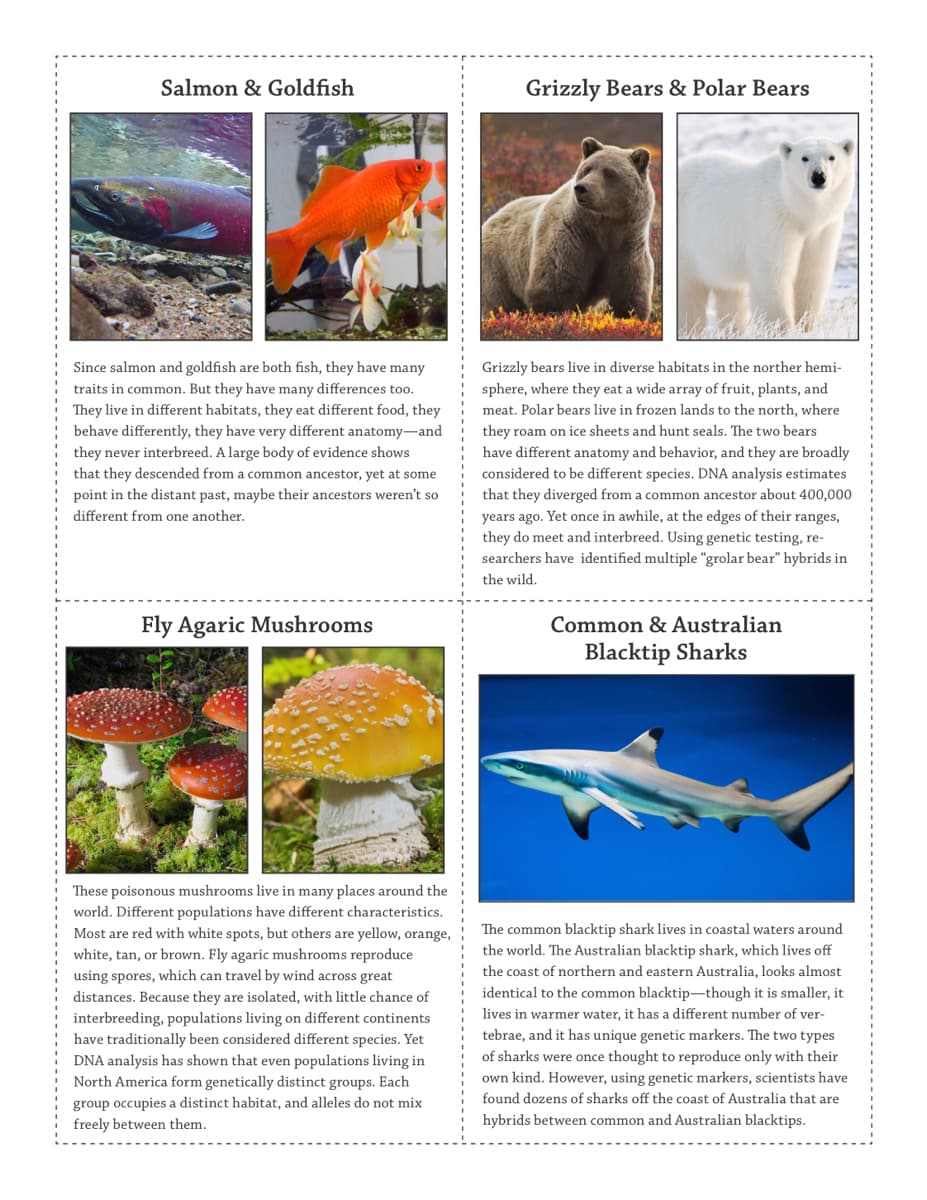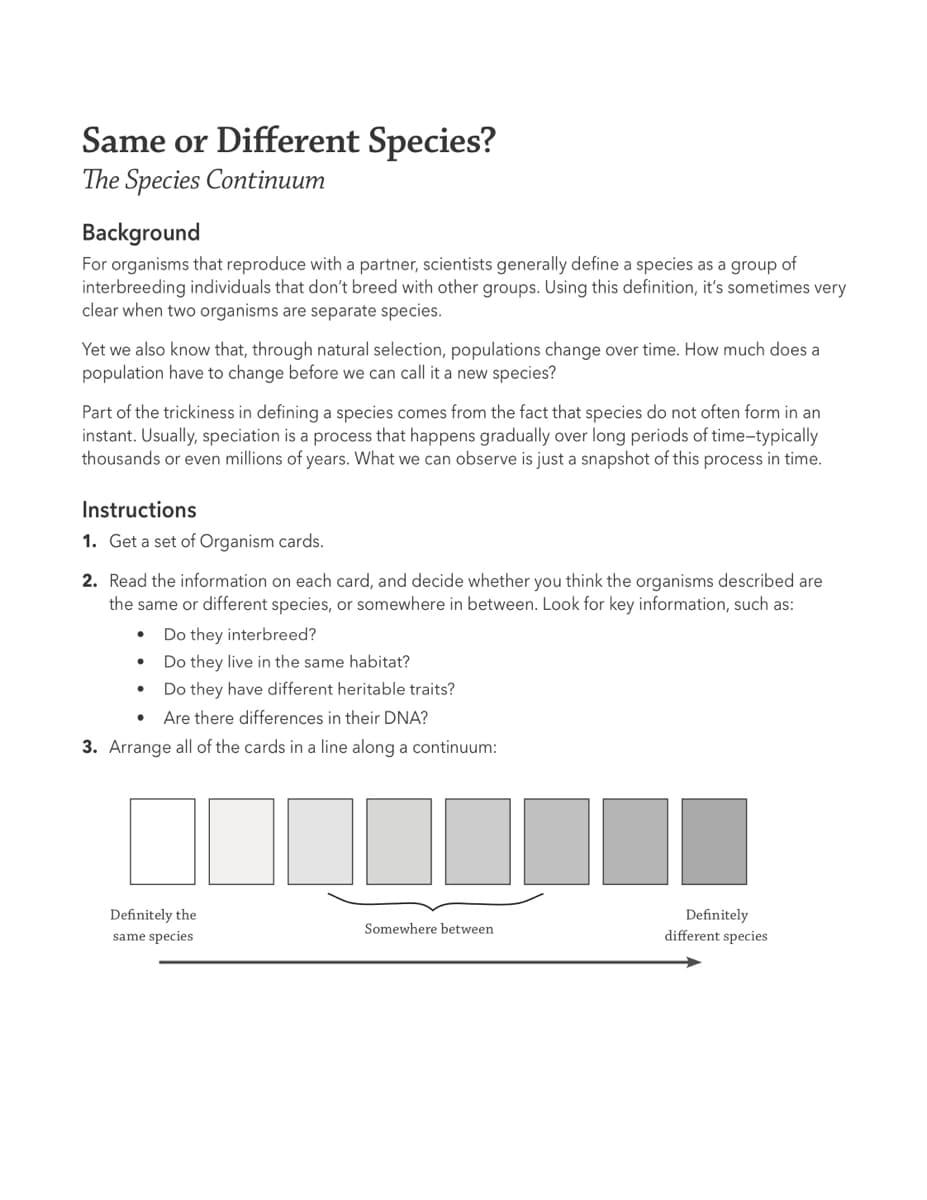Read the information on each card, and decide whether you think the organisms described are the same or different species, or somewhere in between. Look for key information, such as: • Do they interbreed? • Do they live in the same habitat? • Do they have different heritable traits? • Are there differences in their DNA?
Read the information on each card, and decide whether you think the organisms described are the same or different species, or somewhere in between. Look for key information, such as: • Do they interbreed? • Do they live in the same habitat? • Do they have different heritable traits? • Are there differences in their DNA?
Biology: The Unity and Diversity of Life (MindTap Course List)
14th Edition
ISBN:9781305073951
Author:Cecie Starr, Ralph Taggart, Christine Evers, Lisa Starr
Publisher:Cecie Starr, Ralph Taggart, Christine Evers, Lisa Starr
Chapter43: Animal Behavior
Section: Chapter Questions
Problem 2CT
Related questions
Question
100%
What evidence led to these decisions? There should be at least one line per pair.

Transcribed Image Text:Salmon & Goldfish
Grizzly Bears & Polar Bears
Since salmon and goldfish are both fish, they have many
Grizzly bears live in diverse habitats in the norther hemi-
traits in common. But they have many differences too.
They live in different habitats, they eat different food, they
sphere, where they eat a wide array of fruit, plants, and
meat. Polar bears live in frozen lands to the north, where
behave differently, they have very different anatomy-and
they roam on ice sheets and hunt seals. The two bears
they never interbreed. A large body of evidence shows
have different anatomy and behavior, and they are broadly
considered to be different species. DNA analysis estimates
that they diverged from a common ancestor about 400,000
years ago. Yet once in awhile, at the edges of their ranges,
they do meet and interbreed. Using genetic testing, re-
searchers have identified multiple "grolar bear" hybrids in
that they descended from a common ancestor, yet at some
point in the distant past, maybe their ancestors weren't so
different from one another.
the wild.
Fly Agaric Mushrooms
Common & Australian
Blacktip Sharks
These poisonous mushrooms live in many places around the
world. Different populations have different characteristics.
Most are red with white spots, but others are yellow, orange,
white, tan, or brown. Fly agaric mushrooms reproduce
using spores, which can travel by wind across great
The common blacktip shark lives in coastal waters around
the world. The Australian blacktip shark, which lives off
the coast of northern and eastern Australia, looks almost
identical to the common blacktip-though it is smaller, it
distances. Because they are isolated, with little chance of
interbreeding, populations living on different continents
have traditionally been considered different species. Yet
DNA analysis has shown that even populations living in
lives in warmer water, it has a different number of ver-
tebrae, and it has unique genetic markers. The two types
of sharks were once thought to reproduce only with their
own kind. However, using genetic markers, scientists have
North America form genetically distinct groups. Each
found dozens of sharks off the coast of Australia that are
group occupies a distinct habitat, and alleles do not mix
freely between them.
hybrids between common and Australian blacktips.

Transcribed Image Text:Same or Different Species?
The Species Continuum
Background
For organisms that reproduce with a partner, scientists generally define a species as a group of
interbreeding individuals that don't breed with other groups. Using this definition, it's sometimes very
clear when two organisms are separate species.
Yet we also know that, through natural selection, populations change over time. How much does a
population have to change before we can call it a new species?
Part of the trickiness in defining a species comes from the fact that species do not often form in an
instant. Usually, speciation is a process that happens gradually over long periods of time-typically
thousands or even millions of years. What we can observe is just a snapshot of this process in time.
Instructions
1. Get a set of Organism cards.
2. Read the information on each card, and decide whether you think the organisms described are
the same or different species, or somewhere in between. Look for key information, such as:
Do they interbreed?
Do they live in the same habitat?
Do they have different heritable traits?
Are there differences in their DNA?
3. Arrange all of the cards in a line along a continuum:
Definitely the
Definitely
different species
Somewhere between
same species
Expert Solution
This question has been solved!
Explore an expertly crafted, step-by-step solution for a thorough understanding of key concepts.
This is a popular solution!
Trending now
This is a popular solution!
Step by step
Solved in 3 steps

Knowledge Booster
Learn more about
Need a deep-dive on the concept behind this application? Look no further. Learn more about this topic, biology and related others by exploring similar questions and additional content below.Recommended textbooks for you

Biology: The Unity and Diversity of Life (MindTap…
Biology
ISBN:
9781305073951
Author:
Cecie Starr, Ralph Taggart, Christine Evers, Lisa Starr
Publisher:
Cengage Learning

Biology: The Unity and Diversity of Life (MindTap…
Biology
ISBN:
9781337408332
Author:
Cecie Starr, Ralph Taggart, Christine Evers, Lisa Starr
Publisher:
Cengage Learning

Human Heredity: Principles and Issues (MindTap Co…
Biology
ISBN:
9781305251052
Author:
Michael Cummings
Publisher:
Cengage Learning

Biology: The Unity and Diversity of Life (MindTap…
Biology
ISBN:
9781305073951
Author:
Cecie Starr, Ralph Taggart, Christine Evers, Lisa Starr
Publisher:
Cengage Learning

Biology: The Unity and Diversity of Life (MindTap…
Biology
ISBN:
9781337408332
Author:
Cecie Starr, Ralph Taggart, Christine Evers, Lisa Starr
Publisher:
Cengage Learning

Human Heredity: Principles and Issues (MindTap Co…
Biology
ISBN:
9781305251052
Author:
Michael Cummings
Publisher:
Cengage Learning

Biology Today and Tomorrow without Physiology (Mi…
Biology
ISBN:
9781305117396
Author:
Cecie Starr, Christine Evers, Lisa Starr
Publisher:
Cengage Learning